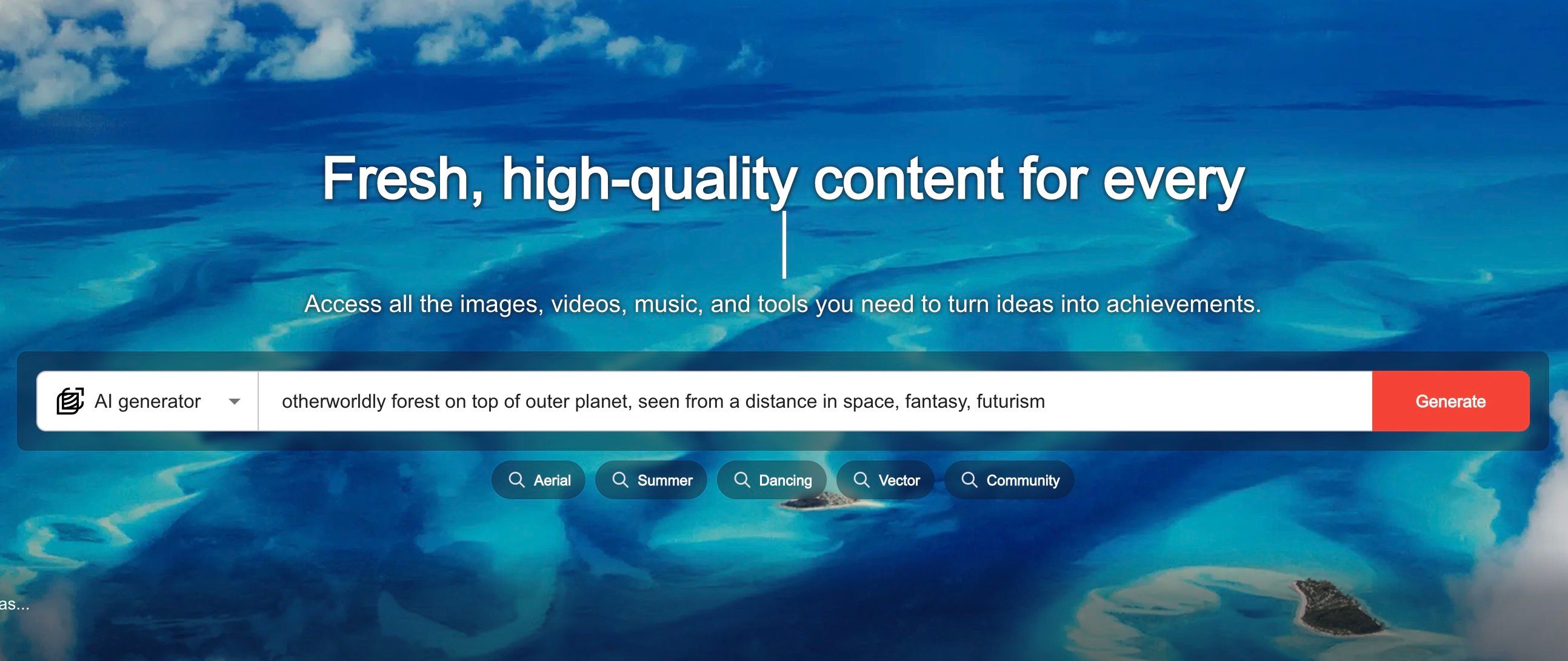Welcome to the exciting world of selling AI-generated images! If you’re a digital artist or tech enthusiast, you’ve probably heard about AI art and wondered how you can turn your creations into income. Shutterstock, one of the biggest stock image platforms out there, has started embracing AI-generated content, opening new doors for creators like you. But navigating the rules and making sure your images get approved can be tricky. Don’t worry—we’re here to guide you through the process of selling your AI art successfully on Shutterstock. Let’s dive in and explore what you need to know!
Understanding Shutterstock’s Policies on AI-Generated Content

Before you start uploading your AI-created images, it’s crucial to understand Shutterstock’s policies regarding AI-generated content. The platform aims to maintain high-quality standards and ensure transparency for buyers, so they have specific guidelines you need to follow.
Here’s what you should know:
- Disclosure: Shutterstock requires contributors to clearly disclose when an image is AI-generated. This helps maintain transparency and builds trust with buyers.
- Quality Standards: AI images must meet Shutterstock’s quality standards, including high resolution, proper composition, and no visible artifacts or distortions.
- Originality and Uniqueness: Your AI images should be original and not infringe on existing copyrights. Avoid using copyrighted inputs or datasets without permission.
- Content Restrictions: Shutterstock prohibits AI-generated images that contain explicit, violent, or controversial content. Make sure your images adhere to their content guidelines.
Additionally, Shutterstock has specific requirements for the metadata you provide. Be honest and accurate when describing your AI-generated images, including details about the tools or algorithms used. This not only ensures compliance but also helps buyers find your work more easily.
By understanding and adhering to these policies, you can confidently upload your AI art and maximize your chances of making sales. Remember, transparency and quality are key in building a reputable portfolio on Shutterstock!
Creating High-Quality AI-Generated Images for Sale
When it comes to selling AI-generated images on Shutterstock, quality is king. You want your images to stand out in a crowded marketplace, and that means focusing on creating visuals that are not only eye-catching but also polished and professional. So, how do you ensure your AI creations hit that mark?
First things first: start with a clear concept. Think about what kind of images are in demand—think vibrant illustrations, serene landscapes, or modern abstract designs. Use prompts that are specific enough to guide the AI but still allow room for creativity. For example, instead of saying “a city,” try “a futuristic city skyline at sunset with neon lights.”
Next, pay attention to the resolution and details. Most AI tools let you generate images at high resolutions, which is essential for stock images. Aim for at least 3000 pixels on the shortest side to ensure your images are suitable for various uses. Remember, Shutterstock reviewers prioritize sharp, clear images without pixelation.
Don’t forget about composition and balance. Use the rule of thirds, leading lines, and negative space to make your images more aesthetically pleasing. Even if the AI generates the initial concept, you can use editing tools like Photoshop or GIMP to enhance composition, adjust colors, or clean up any imperfections.
Another tip: focus on unique, niche content. While many AI images can be generic, try creating images that fill a specific gap or niche. For example, illustrations tailored for tech startups, eco-friendly themes, or educational infographics tend to perform well.
Lastly, always review your images critically. Check for any artifacts, distortions, or unnatural elements that might have been introduced during generation. A high-quality, clean image will have a better chance of passing Shutterstock’s review process and appealing to buyers.
Remember, creating top-tier AI images takes practice. Don’t be discouraged if your first few attempts aren’t perfect. Experiment with different prompts, styles, and editing techniques, and over time, you’ll develop a portfolio of images that truly stand out in the marketplace.
Preparing Your Images for Upload and Optimization
Once you’ve created stunning AI-generated images, the next step is preparing them for upload to Shutterstock. Proper preparation not only ensures your images meet the platform’s standards but also helps them get noticed by potential buyers.
First, check Shutterstock’s technical requirements. Typically, they prefer images in JPEG format with sRGB color profile, a resolution of at least 3000 pixels on the shortest side, and a file size that doesn’t exceed their limits (usually around 50MB). Make sure your images adhere to these specs before uploading.
Next, consider image optimization. Even high-quality images can benefit from slight adjustments to enhance visual appeal. Use photo editing software to:
- Adjust brightness and contrast to make your images pop.
- Sharpen details to improve clarity.
- Remove any imperfections or artifacts that might distract or diminish quality.
- Crop and straighten to ensure perfect framing.
It’s also crucial to add relevant metadata—titles, descriptions, and keywords. Use descriptive and accurate keywords that reflect the content of your image. Think about what potential buyers might search for. For example, if your image features a modern workspace, keywords like “office,” “workspace,” “technology,” and “business” will help it appear in relevant searches.
When writing your descriptions, be clear and concise, highlighting key elements of the image. This not only improves discoverability but also helps Shutterstock reviewers understand the context and quality of your work.
Additionally, consider watermarking your images with a discreet overlay until they’re approved. This prevents unauthorized use while in review. Once approved, you can remove the watermark for the final uploads.
Lastly, organize your images logically in your storage system. Use descriptive filenames—something like “futuristic-city-sunset.jpg”—so you can easily find and upload the right images when needed.
By paying attention to these details, you increase your chances of getting your images accepted and making a strong impression on buyers. Remember, a well-prepared image not only passes review smoothly but also sells better in the long run.
Navigating the Submission Process on Shutterstock
Once you’ve created some stunning AI-generated images that you’re excited to share, the next step is submitting them to Shutterstock. It might seem a bit daunting at first, especially if you’re new to the platform, but don’t worry—it’s pretty straightforward once you get the hang of it.
First off, you’ll need to create a contributor account if you haven’t already. Head over to Shutterstock’s contributor portal and sign up. They’ll ask for some basic information and may review your account before approval. Once you’re in, you’re ready to upload your images.
Here’s a quick rundown of the submission steps:
- Prepare Your Files: Make sure your AI-generated images meet Shutterstock’s technical requirements—usually JPEG format, 4 MP minimum resolution, and no visible watermarks or branding.
- Log In and Access the Upload Tool: Use your contributor account to log in. Navigate to the upload section, which is usually easy to find on your dashboard.
- Upload Your Images: Select your files and upload them. You can upload multiple images at once, which saves time.
- Add Metadata: This part is crucial. Provide clear and descriptive titles, keywords, and categories. Think about what a buyer might search for—use relevant keywords but avoid keyword stuffing.
- Choose Licensing Options: Shutterstock offers Standard and Enhanced licenses. Standard is most common, but if your images have commercial use potential, consider the Enhanced license.
- Review and Submit: Double-check your uploads for accuracy. Once satisfied, hit submit. Your images will go into a review queue where Shutterstock’s reviewers will assess quality and originality.
The review process typically takes a few days. If your images are accepted, they’ll be published on the platform and available for buyers to license. If not, Shutterstock usually provides feedback on why they were rejected, which can help you improve your future submissions.
Remember, consistency is key. The more high-quality, unique images you submit, the more visibility you’ll gain. And don’t forget to stay updated with Shutterstock’s submission guidelines, as they sometimes change or get more specific for certain content types.
Tips for Increasing Visibility and Sales of Your AI-Generated Images
Getting your images approved is just the beginning. To truly succeed on Shutterstock, you need to make sure your images stand out and reach the right audience. Here are some practical tips to boost your visibility and sales:
Optimize Your Metadata
Think of metadata as your images’ digital storefront. Use relevant, specific keywords that accurately describe your image. Avoid generic terms—be detailed and precise. For example, instead of just “city,” try “futuristic city skyline at sunset.” Good metadata helps your images appear in relevant searches.
Consistent Uploading
Regularly adding new images keeps your portfolio fresh and signals activity to Shutterstock’s algorithm. Over time, this can improve your visibility. Aim to upload new AI-generated images at a steady pace, focusing on quality over quantity.
Target Popular and Trending Topics
Stay aware of current trends and popular themes. If AI allows you to generate images on trending topics—like sustainability, technology, or health—capitalize on that. Popular themes tend to get more searches and downloads.
Leverage Unique and High-Quality Content
AI gives you the power to produce highly unique images that might be hard to find elsewhere. Use this to your advantage by creating distinctive visuals that fill gaps in the marketplace. High-resolution, well-composed images will also attract more buyers.
Engage with the Community
Comment, share, and participate in Shutterstock’s contributor forums and social media groups. Networking with other contributors can provide valuable insights, tips, and even collaborations that boost your exposure.
Monitor Your Performance
Use Shutterstock’s analytics tools to see which images perform best. Pay attention to metrics like views, downloads, and earnings. Adjust your strategy accordingly—if certain themes or styles sell better, focus more on those areas.
Promote on Outside Channels
While Shutterstock traffic is a big driver, don’t underestimate the power of external promotion. Share your portfolio on your personal website, social media, or niche online communities. The more exposure your work gets, the higher your chances of making sales.
Remember, patience and persistence are vital. Building a successful portfolio of AI-generated images on Shutterstock takes time, but with consistent effort and smart strategies, you’ll be well on your way to turning your creative AI outputs into a steady income stream.
Legal Considerations and Copyright Issues for AI Art
When it comes to selling AI-generated images, one of the most important aspects to consider is the legal landscape surrounding copyright and intellectual property. It’s a bit of a gray area because AI art blends human creativity with machine algorithms, and laws haven’t fully caught up yet. Still, there are some key points you should keep in mind to avoid potential pitfalls.
First off, who owns the rights? Traditionally, copyright law grants rights to human creators. But with AI art, the question becomes: is the creator the person who trained the AI, the person who input the prompts, or the AI itself? Currently, most jurisdictions recognize only human authorship, so the person who creates or guides the AI typically holds the rights — but this can vary depending on the platform and the specific circumstances.
Next, be aware of the source of the AI training data. Many AI models are trained on vast datasets that include copyrighted images. If your AI tool used copyrighted images without permission, there’s a risk that your generated images could infringe on those rights, especially if they resemble the original copyrighted works. Always check if your AI tool is trained on licensed or public domain datasets.
Shutterstock’s policies are also crucial. They explicitly state that contributors must have the rights to submit their images. When submitting AI-generated images, it’s best to include clear information about how the images were created, including the use of AI tools. Transparency can help in defending your rights and avoiding disputes.
Another consideration is disclosure and licensing. If your AI art features recognizable trademarks, logos, or people, you might need model or property releases. Even if your images are entirely AI-generated, be cautious about creating images that could be mistaken for real individuals or proprietary content.
Lastly, stay informed about evolving legislation. Copyright laws around AI are changing, and platforms like Shutterstock often update their policies accordingly. To stay on the safe side, always keep your knowledge current and consider consulting legal professionals if you’re unsure about your specific situation.
Conclusion and Best Practices for Success on Shutterstock
Congratulations! You’re now equipped with the essentials to start selling your AI-generated images on Shutterstock. While the process might seem daunting at first, following some best practices can significantly boost your chances of success and help you navigate the unique challenges of AI art.
Here are some key tips to keep in mind:
- Create high-quality, unique images: Focus on originality and technical excellence. The more polished and distinctive your images are, the more likely they are to stand out and attract buyers.
- Understand Shutterstock’s guidelines: Always review their content policies, especially regarding AI-generated work. Properly categorize and tag your images to improve discoverability.
- Be transparent: When submitting AI-created images, mention that they were generated with AI tools. Transparency builds trust with buyers and platform reviewers.
- Stay organized: Keep records of your creation process, including prompts, tools used, and licensing details. This documentation can be invaluable if questions or disputes arise.
- Engage with the community: Join forums, social media groups, or Shutterstock contributor communities. Learning from others’ experiences can provide valuable insights and inspiration.
- Keep learning and experimenting: AI art is a rapidly evolving field. Stay updated on new tools, techniques, and legal developments to keep your portfolio fresh and compliant.
- Promote your work: Share your images on social media or personal websites to drive traffic back to your Shutterstock portfolio. The more exposure your work gets, the better your sales potential.
In summary, selling AI-generated images on Shutterstock can be a rewarding venture if approached thoughtfully. Prioritize quality, transparency, and compliance, and you’ll be well on your way to building a successful digital art business. Happy creating and selling!


